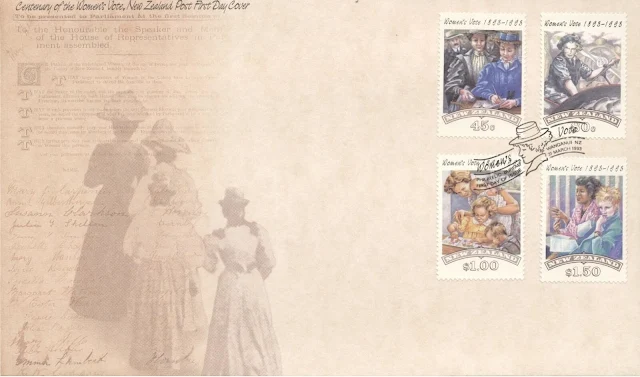Women being allowed the right to vote was a monumental change in New Zealand’s history. It was a change that was controversial at the time but went on to lead New Zealand into a much brighter future. What is also important to recognise is that New Zealand was a world leader in social change, one of the first countries to give women the right to vote.
This issue marked 100 years since women received voting rights in New Zealand.
NZ Suffrage on Stamps - A Thematic Collection.
This issue marked 100 years since women received voting rights in New Zealand.
NZ Suffrage on Stamps - A Thematic Collection.
45c - The First Vote - 1893.
In 1893 nearly one in every four New Zealand women signed a petition urging Parliament to recognise their right to vote. In September that year, New Zealand women became the first in the world to be granted voting rights in general elections.
80c - Second World War Work.
During World War II the demand for labour saw women taking on many jobs previously only open to men, and in the process, the prejudice against married women working began to change. After the war, many women continued as members of the paid workforce.
$1.00 - Child Care.
Attitudes about child care have changed considerably in the last 40 years. Many women now combine raising children with work outside the home - some by choice, others through necessity - and men are playing a more active role in caring for children. Nonetheless, women continue to be the principal caregivers.
$1.50 - Contemporary Women.
As women's lives have become more varied and in many ways richer than their forebears', awareness of those earlier women's efforts to bring about change has also grown. Those efforts continue today. Healthcare, access to top jobs, economic independence for women at home, and reduction of violence against women are just some areas which women, and many men, continue to address.
First Day Cover - 31 March 1993
Organised pressure to grant women the vote began as early as 1885 with the formation of the Women's Christian Temperance Union, which was dedicated to a broad range of social and moral reforms, including a greater say in government for women. Under the leadership of Kate Sheppard, the WCTU submitted three nationwide petitions to Parliament asking for the removal of the Electoral Bill stipulation that "Persons does not include female".
Despite the opposition of every member of the Liberal Party cabinet, including the premier, Richard Seddon, the third petition in 1893 finally convinced the House of Representatives to pass the Suffrage Bill, allowing women to vote.
To become law the Bill then had to be passed by the Legislative Chamber, or Upper House. As members wavered, suffragists telegrammed them with a message which read: "Understand the fate of franchise depends on your vote. Oh, fail us not!!"
When some members of the House then tried to pressure the Governor, Lord Glasgow, to withhold his assent to the Bill, suffragists bombarded him with telegrams and deputations. On 19 September 1893, he gave his assent and New Zealand became the first nation to allow women to vote in general elections.
It was not, however, until 1919 that women were actually allowed to stand for Parliament. The first woman MP was elected in 1933 when Elizabeth McCombs won the seat left vacant by her husband's death.
Technical Information.
Date of Issue: 31 March 1993.
Designer: Lindy Fisher, Auckland, NZ.
Printer: Southern Colour Print, Dunedin.
Stamp Size: 28mm x 40mm.
Sheet Size: 100 stamps per sheet.
Process: Lithography.
Perforation Gauge: 13.5.
Paper Type: Peterborough Paper Converters, red phosphor coated, unwatermarked.
Some of the images in this post were used with permission from the illustrated catalogue of StampsNZ
You can visit their website and Online Catalogue at, http://stampsnz.com/
Information for this post came from.





We appreciate your engagement with our content. To ensure a respectful and constructive community, please take note of the following:
- No Spam, Please: We do not tolerate spammy or promotional comments. Any such comments will be promptly removed.
- Moderation in Place: All comments are moderated to maintain a positive and inclusive environment. Please be patient, as it may take a little time for your comment to appear.
- Sign In with Google: To comment, please sign in using your Google account. This helps us maintain the integrity of our community and allows for better interaction.